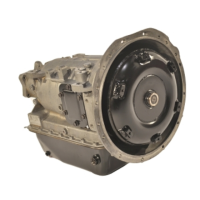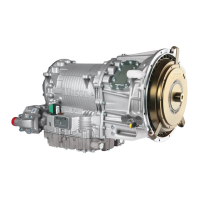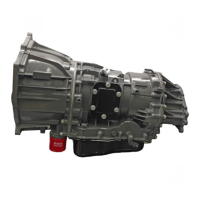Copyright © 1996 General Motors Corp. 2–9
DESCRIPTION AND OPERATION
ulator pressure causes a downshift if governor pressure
alone will not hold the valve upward against spring
force.
(4) For the earlier models main-pressure reg-
ulator valve, modulator pressure exerts a downward
force on the valve. An increase in modulator pressure
causes a decrease in main pressure; a decrease in mod-
ulator pressure causes an increase in main pressure.
(5) Before S/N 34501, modulator pressure is
blocked by the separator plate at the trimmer regulator
valve. The trimmer regulator valve is either isolated
and not functional or is not present.
(6) After S/N 34500, modulator pressure is
directed to the trimmer regulator valve, exerting an
upward force against its spring. This causes a reduc-
tion in trimmer regulator pressure at the trimmer
valves.
i. Clutch Circuits
(1) Each of the five clutches has its own cir-
cuit. Each clutch, except forward, is connected to a re-
lay valve and a trimmer valve. The forward clutch is
connected directly to the selector valve. It does not re-
quire connection to a trimmer valve because its appli-
cation (except in a neutral-to-first range shift) precedes
the application of an additional clutch, which is
trimmed.
(2) The first clutch circuit (red and white)
connects the clutch to the 1–2 relay valve and to the
first clutch trimmer valve. In neutral, the 1–2 relay
valve is held upward by spring force, and main pres-
sure is directed to the first clutch circuit. The 1–2 relay
valve does not move downward unless the 1–2 signal
line is charged. This will not occur in neutral because
there is no governor pressure to shift the 1–2 signal
valve.
j. Hold Regulator Valve
(1) The various hold ranges limit the high-
est range attainable by introducing a pressure which
prevents governor pressure from upshifting the signal
valves. This pressure is a regulated, reduced pressure
derived from main pressure at the hold regulator
valve.
(2) Hold regulator pressure at each shift sig-
nal valve will push the modulator valve upward, and
hold the shift valve down against governor pressure.
Thus, when hold regulator pressure is present, an up-
shift can occur at that shift signal valve only with ex-
cessive overspeed.
k. Automatic Upshifts
(1) When the transmission is operating in
first range (or second range, earlier model transmis-
sions with second range start), with the selector valve
at
D
(Drive), a combination of governor pressure and
modulator pressure, or governor pressure alone, will
upshift the transmission to the next range. At closed or
part throttle, modulator pressure assists governor pres-
sure. At full throttle, there is no modulator pressure.
Thus, upshifts occur sooner when the throttle is closed
and are delayed when the throttle is open.
(2) When governor pressure is sufficient, the
first upshift will occur. A further increase in governor
pressure (output speed) will cause subsequent up-
shifts.
(3) In any automatic upshift, the shift signal
valve acts first. This directs a shift signal pressure to
the relay valve. The relay valve moves downward, ex-
hausting the applied clutch and applying a clutch for
the next higher range.
l. Automatic Downshifts
(1) Automatic downshifts, like upshifts, are
controlled by governor and modulator pressures.
Downshifts occur in sequence as governor pressure
and/or modulator pressures decrease. Low modulator
pressure (open throttle) will cause a sooner downshift;
high modulator pressure (closed throttle) will cause a
delayed downshift.
(2) In any automatic downshift, the shift sig-
nal valve acts first. This exhausts the shift signal hold-
ing the relay valve downward. The relay valve then
moves upward, exhausting the applied clutch and ap-
plying the clutch for the next lower range.
m. Downshift Inhibiting
(1) Inherent in the system is a means for pre-
venting downshifts at a too rapid rate. For example, if
the vehicle is traveling at a high speed in fourth range

